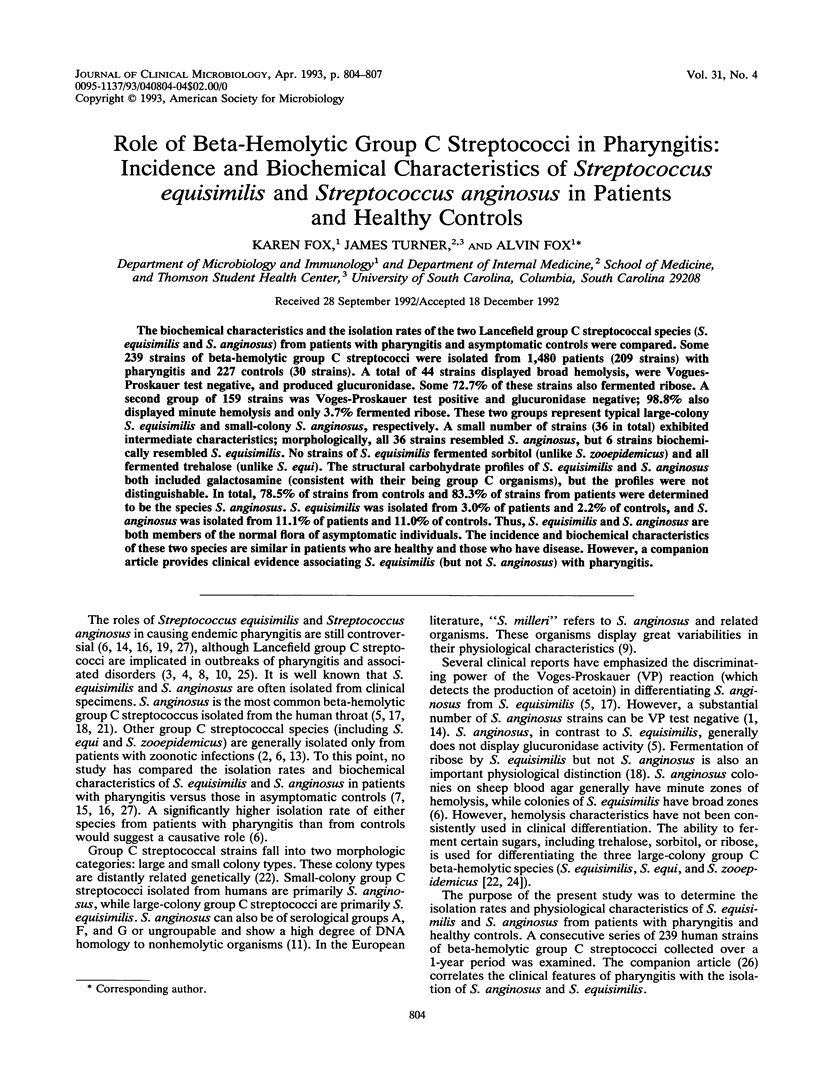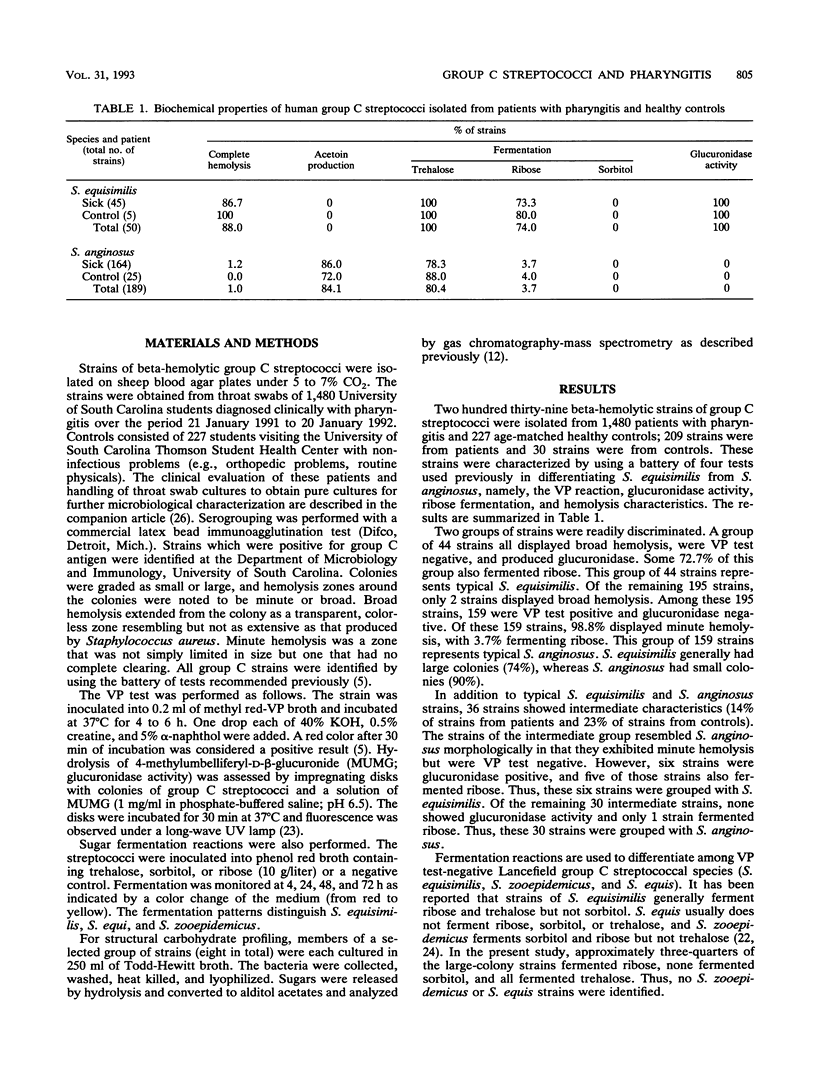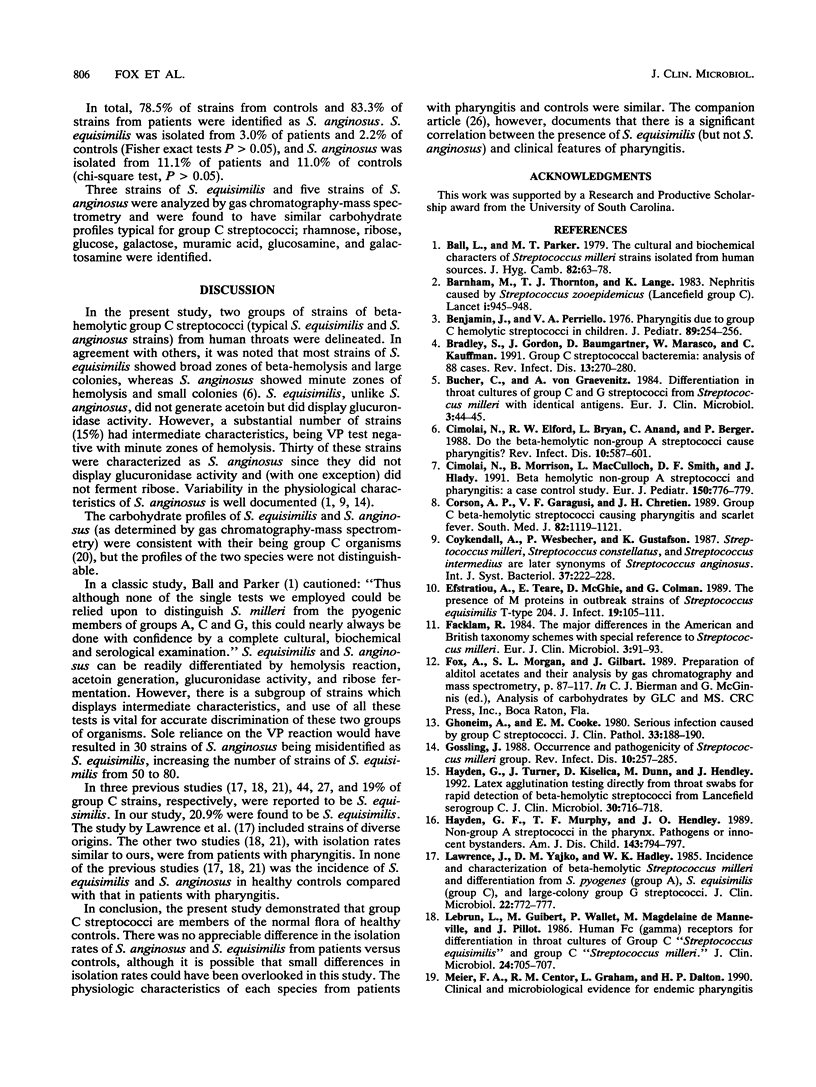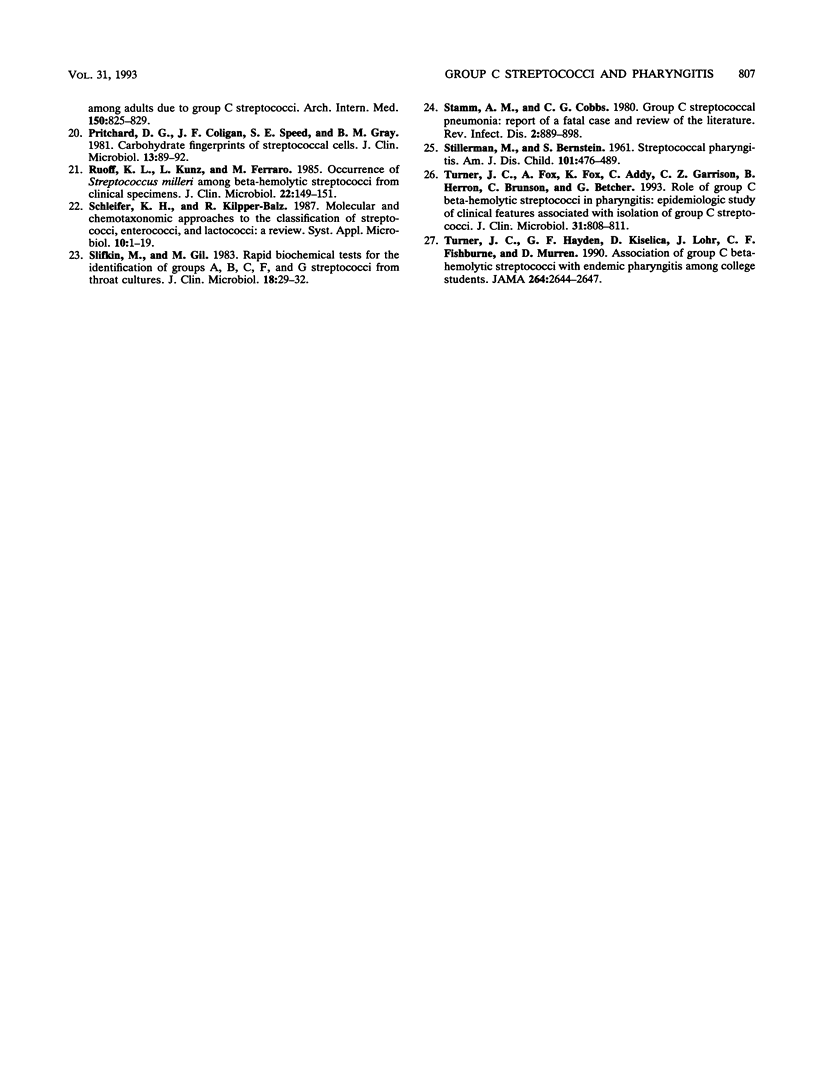Abstract
The biochemical characteristics and the isolation rates of the two Lancefield group C streptococcal species (S. equisimilis and S. anginosus) from patients with pharyngitis and asymptomatic controls were compared. Some 239 strains of beta-hemolytic group C streptococci were isolated from 1,480 patients (209 strains) with pharyngitis and 227 controls (30 strains). A total of 44 strains displayed broad hemolysis, were Voges-Proskauer test negative, and produced glucuronidase. Some 72.7% of these strains also fermented ribose. A second group of 159 strains was Voges-Proskauer test positive and glucuronidase negative; 98.8% also displayed minute hemolysis and only 3.7% fermented ribose. These two groups represent typical large-colony S. equisimilis and small-colony S. anginosus, respectively. A small number of strains (36 in total) exhibited intermediate characteristics; morphologically, all 36 strains resembled S. anginosus, but 6 strains biochemically resembled S. equisimilis. No strains of S. equisimilis fermented sorbitol (unlike S. zooepidemicus) and all fermented trehalose (unlike S. equi). The structural carbohydrate profiles of S. equisimilis and S. anginosus both included galactosamine (consistent with their being group C organisms), but the profiles were not distinguishable. In total, 78.5% of strains from controls and 83.3% of strains from patients were determined to be the species S. anginosus. S. equisimilis was isolated from 3.0% of patients and 2.2% of controls, and S. anginosus was isolated from 11.1% of patients and 11.0% of controls. Thus, S. equisimilis and S. anginosus are both members of the normal flora of asymptomatic individuals. The incidence and biochemical characteristics of these two species are similar in patients who are healthy and those who have disease. However, a companion article provides clinical evidence associating S. equisimilis (but not s. anginosus) with pharyngitis.
Full text
PDF



Selected References
These references are in PubMed. This may not be the complete list of references from this article.
- Ball L. C., Parker M. T. The cultural and biochemical characters of Streptococcus milleri strains isolated from human sources. J Hyg (Lond) 1979 Feb;82(1):63–78. doi: 10.1017/s002217240002547x. [DOI] [PMC free article] [PubMed] [Google Scholar]
- Barnham M., Thornton T. J., Lange K. Nephritis caused by Streptococcus zooepidemicus (Lancefield group C). Lancet. 1983 Apr 30;1(8331):945–948. doi: 10.1016/s0140-6736(83)92078-0. [DOI] [PubMed] [Google Scholar]
- Benjamin J. T., Perriello V. A., Jr Pharyngitis due to group C hemolytic streptococci in children. J Pediatr. 1976 Aug;89(2):254–256. doi: 10.1016/s0022-3476(76)80459-3. [DOI] [PubMed] [Google Scholar]
- Bradley S. F., Gordon J. J., Baumgartner D. D., Marasco W. A., Kauffman C. A. Group C streptococcal bacteremia: analysis of 88 cases. Rev Infect Dis. 1991 Mar-Apr;13(2):270–280. doi: 10.1093/clinids/13.2.270. [DOI] [PubMed] [Google Scholar]
- Bucher C., von Graevenitz A. Differentiation in throat cultures of group C and G streptococci from Streptococcus milleri with identical antigens. Eur J Clin Microbiol. 1984 Feb;3(1):44–45. doi: 10.1007/BF02032818. [DOI] [PubMed] [Google Scholar]
- Cimolai N., Elford R. W., Bryan L., Anand C., Berger P. Do the beta-hemolytic non-group A streptococci cause pharyngitis? Rev Infect Dis. 1988 May-Jun;10(3):587–601. doi: 10.1093/clinids/10.3.587. [DOI] [PubMed] [Google Scholar]
- Cimolai N., Morrison B. J., MacCulloch L., Smith D. F., Hlady J. Beta-haemolytic non-group A streptococci and pharyngitis: a case-control study. Eur J Pediatr. 1991 Sep;150(11):776–779. doi: 10.1007/BF02026709. [DOI] [PubMed] [Google Scholar]
- Corson A. P., Garagusi V. F., Chretien J. H. Group C beta-hemolytic streptococci causing pharyngitis and scarlet fever. South Med J. 1989 Sep;82(9):1119–1121. doi: 10.1097/00007611-198909000-00015. [DOI] [PubMed] [Google Scholar]
- Efstratiou A., Teare E. L., McGhie D., Colman G. The presence of M proteins in outbreak strains of Streptococcus equisimilis T-type 204. J Infect. 1989 Sep;19(2):105–111. doi: 10.1016/s0163-4453(89)91789-1. [DOI] [PubMed] [Google Scholar]
- Ghoneim A. T., Cooke E. M. Serious infection caused by group C streptococci. J Clin Pathol. 1980 Feb;33(2):188–190. doi: 10.1136/jcp.33.2.188. [DOI] [PMC free article] [PubMed] [Google Scholar]
- Gossling J. Occurrence and pathogenicity of the Streptococcus milleri group. Rev Infect Dis. 1988 Mar-Apr;10(2):257–285. doi: 10.1093/clinids/10.2.257. [DOI] [PubMed] [Google Scholar]
- Hayden G. F., Murphy T. F., Hendley J. O. Non-group A streptococci in the pharynx. Pathogens or innocent bystanders? Am J Dis Child. 1989 Jul;143(7):794–797. doi: 10.1001/archpedi.1989.02150190044018. [DOI] [PubMed] [Google Scholar]
- Hayden G. F., Turner J. C., Kiselica D., Dunn M., Hendley J. O. Latex agglutination testing directly from throat swabs for rapid detection of beta-hemolytic streptococci from Lancefield serogroup C. J Clin Microbiol. 1992 Mar;30(3):716–718. doi: 10.1128/jcm.30.3.716-718.1992. [DOI] [PMC free article] [PubMed] [Google Scholar]
- Lawrence J., Yajko D. M., Hadley W. K. Incidence and characterization of beta-hemolytic Streptococcus milleri and differentiation from S. pyogenes (group A), S. equisimilis (group C), and large-colony group G streptococci. J Clin Microbiol. 1985 Nov;22(5):772–777. doi: 10.1128/jcm.22.5.772-777.1985. [DOI] [PMC free article] [PubMed] [Google Scholar]
- Lebrun L., Guibert M., Wallet P., de Maneville M. M., Pillot J. Human Fc(gamma) receptors for differentiation in throat cultures of group C "Streptococcus equisimilis" and group C "Streptococcus milleri". J Clin Microbiol. 1986 Nov;24(5):705–707. doi: 10.1128/jcm.24.5.705-707.1986. [DOI] [PMC free article] [PubMed] [Google Scholar]
- Meier F. A., Centor R. M., Graham L., Jr, Dalton H. P. Clinical and microbiological evidence for endemic pharyngitis among adults due to group C streptococci. Arch Intern Med. 1990 Apr;150(4):825–829. [PubMed] [Google Scholar]
- Pritchard D. G., Coligan J. E., Speed S. E., Gray B. M. Carbohydrate fingerprints of streptococcal cells. J Clin Microbiol. 1981 Jan;13(1):89–92. doi: 10.1128/jcm.13.1.89-92.1981. [DOI] [PMC free article] [PubMed] [Google Scholar]
- Ruoff K. L., Kunz L. J., Ferraro M. J. Occurrence of Streptococcus milleri among beta-hemolytic streptococci isolated from clinical specimens. J Clin Microbiol. 1985 Aug;22(2):149–151. doi: 10.1128/jcm.22.2.149-151.1985. [DOI] [PMC free article] [PubMed] [Google Scholar]
- Slifkin M., Gil G. M. Rapid biochemical tests for the identification of groups A, B, C, F, and G streptococci from throat cultures. J Clin Microbiol. 1983 Jul;18(1):29–32. doi: 10.1128/jcm.18.1.29-32.1983. [DOI] [PMC free article] [PubMed] [Google Scholar]
- Stamm A. M., Cobbs C. G. Group C streptococcal pneumonia: report of a fatal case and review of the literature. Rev Infect Dis. 1980 Nov-Dec;2(6):889–898. doi: 10.1093/clinids/2.6.889. [DOI] [PubMed] [Google Scholar]
- Turner J. C., Fox A., Fox K., Addy C., Garrison C. Z., Herron B., Brunson C., Betcher G. Role of group C beta-hemolytic streptococci in pharyngitis: epidemiologic study of clinical features associated with isolation of group C streptococci. J Clin Microbiol. 1993 Apr;31(4):808–811. doi: 10.1128/jcm.31.4.808-811.1993. [DOI] [PMC free article] [PubMed] [Google Scholar]
- Turner J. C., Hayden G. F., Kiselica D., Lohr J., Fishburne C. F., Murren D. Association of group C beta-hemolytic streptococci with endemic pharyngitis among college students. JAMA. 1990 Nov 28;264(20):2644–2647. [PubMed] [Google Scholar]


